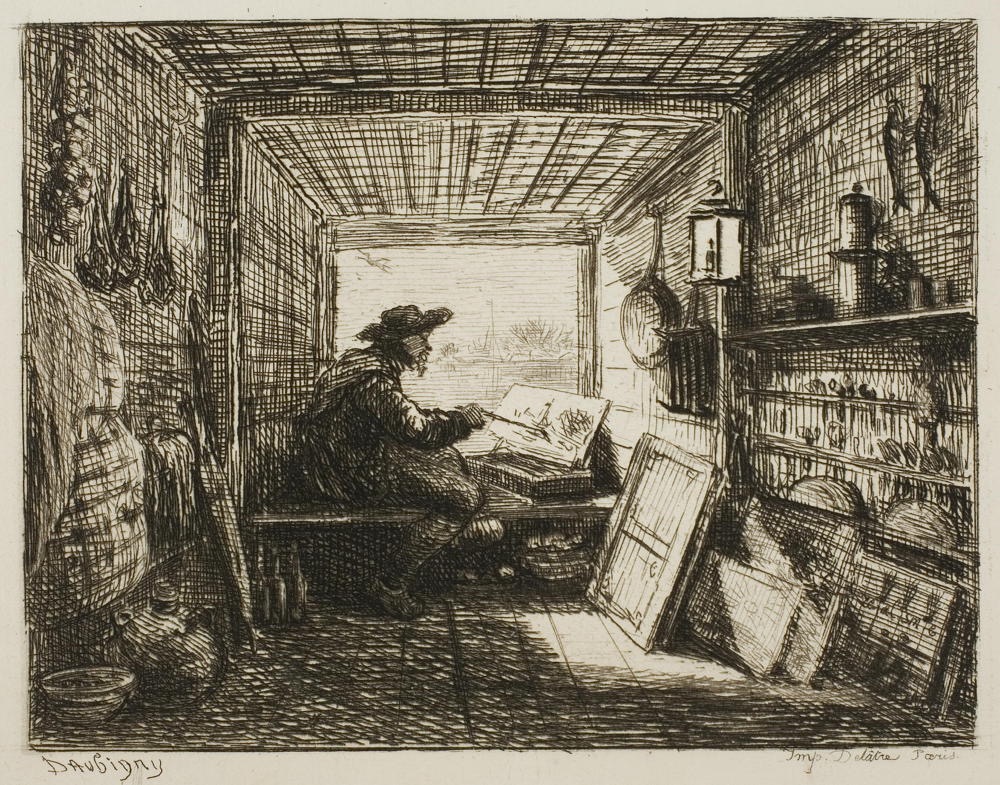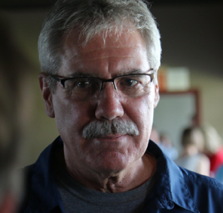PreppingForEternity

Charles François Daubigny: The Boat Studio, from The Boat Trip (1861)
ABOUT THIS ARTWORK
In order to paint the river landscape scenes that accorded so well with his temperament and taste, Daubigny decided to build a floating studio that could be positioned to afford the best points of view and to capture the varied effects of natural light. The etchings that resulted in the series “The Boat Trip” are an early example of the plein-air aesthetic, a practice of working outdoors that the Impressionists would wholeheartedly embrace.
——
"I'll just witness the final installation."
Even the idea of being away from The Villa for more than a week unsettles me. The Muse wisely suggests we refer to it as a road trip rather than as a vacation, and to the extent that such a second-order reframing soothes me, this works! I will not undertake this excursion as if it were a reward for diligently working, but as a much more pedestrian toodle a little further afield than usual. To maintain this illusion, we plan to avoid driving on freeways. The Muse was raised just south of US Highway 12 in NE South Dakota. I was raised just south of the same highway in SE Washington State. Between these two locations lies what now amounts to an ancient route across Montana and South Dakota, one trucks abandoned in favor of the Interstates. Twelve hundred and fifty miles of two-lane blacktop: small towns, scenery, and, with luck, some sanity.
Preparing to leave remains a challenge. Until we finally manage to install an in-ground irrigation system, we must rely upon water timers, hoses, and standalone sprinklers. I have proven myself incapable of programming water timers because nobody who manufactures them has yet tumbled to the notion that mere humans might be called upon to program them. They each employ their own clever machine language more akin to Sanskrit or Finnish than good Ole American English. The Muse figures out the code and even draws a map of the yard showing seven independent watering zones. We just need to confirm that we have enough sprinklers and hoses to service these zones, test the connections, then leave the oversight to Linda Sue, who will be watching the place in our absence. Something always happens to at least one of the sprinklers when we're gone.
Our preparation seems remarkably similar to the work I've been engaging in this week on our never-ending front porch project. I've hired Kurt, my old friend and master painter, to help. I consider painting to be a straightforward process of preparing for eternity. Done correctly, I'll never need to touch up what we're painting for the porch. With Kurt's help, we're building jigs to hold the pieces, which will ease the painting effort. We're applying at least four coats: a sealing layer with a nano-particle product called Guard, which renders the wood permanently waterproof; a prime layer to provide the proper base for the finish coats; and two top coats, one for color and the second for depth. The priming coat must be lightly sanded before the top coats are applied to ensure the satin finish features no bumps or blemishes, since the priming coat dries 'flat,' which means without sheen rather than horizontal.
This seems like a lot of trouble. To compound that, Kurt directed me to sand down some earlier finish coat work I'd completed before he came on the job. He convinced me that the railings should be finished with a satin-textured paint, and I'd completed earlier pieces with flat paint. I feel as though I've been undoing more than making progress. Kurt promises that it will feel like progress once he pulls out his spraying rig. We'll take way too much time setting up those 264 balasters on a 'jig' before painting them perfectly in about an instant with the sprayer, though that will consume more paint than hand-painting them might have. The labor saved will more than offset the extra cost of the paint.
I went to purchase more paint yesterday, only to learn that the price of paint had gone through the roof again. Oil-based primer was going for more than seventy dollars a gallon. The satin finish paint was nearly a hundred. I asked when the next sale would come and was delighted to learn that Friday will bring a forty percent off everything sale. I need three more gallons of primer and five of finish. I will save nearly $300 if the project can hold out until Friday for the paint. We're running out of stockpiling room. Last night we got some real rain. It's a good thing we're doing most of our work on the broad front porch.
What does our Tripping have to do with this painting business? The porch project had served as my excuse for bailing on the Tripping, or had, until The Muse clarified that her invitation for me to go road tripping was not so much an invitation as an insistence. I hate to leave in the middle of preparing the porch parts for eternity, for I will get no second chance to witness this once-in-a-lifetime transformation. I trust Kurt and the carpenters to work productively in my stead, but I still dread my absence. My eventual absence will prove inescapable, and I suppose there will always be unfinished business blocking even the most alluring exits. I prepare for my absence, then, setting sprinklers I will not get to witness working, and painting my porch pieces before the carpenters assemble them. Our chief carpenter came down with shingles this week, so he's bed-bound at the moment. I'd already negotiated with him to hold off assembly and installation until I return. The parts should be ready to face eternity by then. I'll just witness the final installation.
©2025 by David A. Schmaltz - all rights reserved


